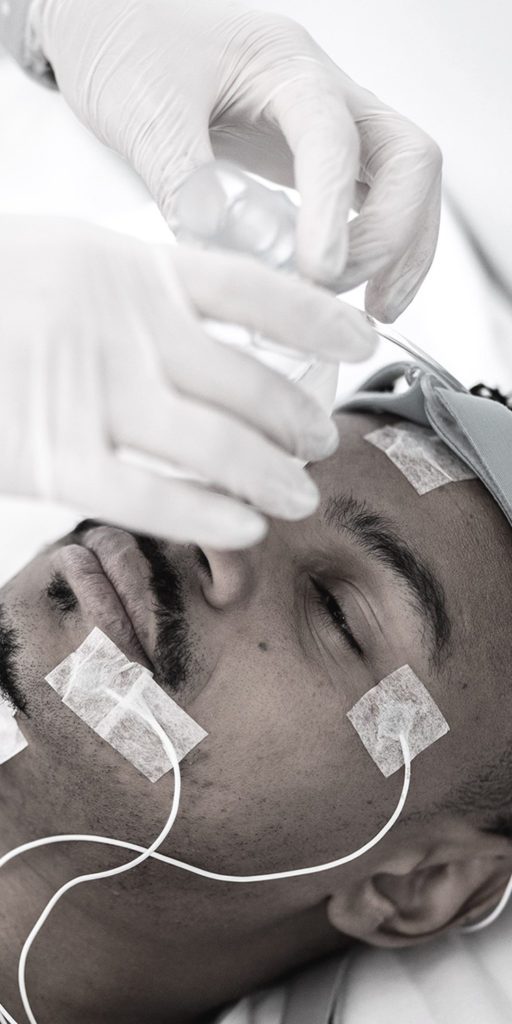In order to determine what kind of sleeping disorders a patient may have, our specialists may schedule a sleep study at one of our sleep centers. Studies include a polysomnogram or MSLT, which helps our specialists identify which sleeping disorder patients have. Sleep studies are easy, painless and require no advance preparation.
Process & Preparation
Patients generally arrive at the Sleep Center by 8 or 9 p.m. They are greeted by a sleep technician, who will care for them throughout the night. Patients may bring their own pajamas and pillow and are encouraged to bring along a book to read. The test will be complete the following morning by 6 a.m.
Upon arrival, the technician explains and prepares the patient for the sleep study. Electrodes are attached to the head and legs, and two plastic belts are positioned around the chest and abdomen. An airflow probe is then placed under the nose. Patients should experience no pain or discomfort during or after the tests. While the patient sleeps, the technician gathers data from the tests for analysis.


Polysomnogram
A polysomnogram, or sleep study, is a test that uses several types of measurements to identify sleep stages and various sleep problems. The brain controls sleep and its different stages including drowsiness, light sleep, deep sleep, and dream sleep. To determine the stage of sleep requires measuring different activities of the brain and body. These activities include brain waves (EEG), eye movements, and muscle tone. A full sleep study will measure other parameters as well, including respiratory effort (chest and abdominal wall movements), cardiac rhythm (EKG), leg movements, and oxygen saturation
Sleep studies also may be videotaped for later review of any abnormal body movements observed during the study.
We monitor the activities that occur during sleep by applying wires with small metal discs called electrodes to the head and skin. Flexible Velcro belts are placed around the chest and abdomen to measure breathing effort. The level of oxygen carried in the blood and heart rate are monitored by a clasp that fits on the index finger. None of these devices are painful and all are designed to be as comfortable as possible. At most sleep lab centers, the surroundings (especially the bedrooms) are relaxing and comfortable, like a hotel room. The technical equipment and technicians will be in a room separate from the sleeping room, and the electrode wires will be gathered together so that rolling over and changing positions will be almost as easy as it would be at home.
The sleep study, its analysis, and interpretation are part of a complex process. Many hours of work are required by specially trained professionals to process or “score” the large amount of data recorded during the study. Asleep specialist, with special knowledge of sleep and its disorders, then interprets this information. A typical sleep study involves more than 800 pages of data and is a time-consuming and labor-intensive process. Results may not be available immediately.
Sleep studies are useful for a number of purposes. They are conducted on patients who have numerous complaints, the majority being excessive daytime sleepiness. Most sleep studies are done to diagnose sleep apnea. Sleep studies are rarely done for patients with insomnia because little useful information is obtained if a patient cannot fall asleep in the lab. The asleep specialist will determine who should or should not have a sleep study.
Following a sleep study, our technicians carefully compile the results of all evaluations and provide them to sleep specialists who evaluate them and make treatment recommendations. All information is forwarded promptly to the patient’s own physician for follow-up and additional treatment.
MSLT
The MSLT follows the overnight sleep study the next day. This test is a series of five naps every two hours lasting approximately 20 minutes each. The purpose is to see if the patient falls asleep during these short periods of time, how long it takes to fall asleep and which stages of sleep the patient has during the intervals. It helps differentiate between narcolepsy and other disorders of excessive somnolence.
Following a sleep study, our technicians carefully compile the results of all evaluations and provide them to sleep specialists who evaluate them and make treatment recommendations. All information is forwarded promptly to the patient’s own physician for follow-up and additional treatment.

EAST
99 N. BRICE RD SUITE 300, COLUMBUS, OH 43213
PHONE: 614-866-8200
REFERRAL FAX: 614-328-2812
MEDICAL RECORDS FAX: 614-328-2809
HOURS
MON-FRI: 8:30 AM – 5:00 PM
GROVE CITY
1905 OHIO DRIVE, GROVE CITY, OH 43123
PHONE: 614-539-5510
FAX: 614-328-2809
HOURS
MON-FRI: 8:30 AM – 5:00 PM
LANCASTER
1973 E. MAIN ST, LANCASTER, OH 43130
PHONE: 740-652-9930
FAX: 614-328-2809
HOURS
MON-FRI: 8:30 AM – 5:00 PM
NEWARK
78 MESSIMER DR, NEWARK, OH 43055
PHONE: 614-866-8200
FAX: 614-328-2809
HOURS
MON-FRI: 8:30 AM – 5:00 PM
POLARIS
1120 POLARIS PARKWAY, SUITE 200, COLUMBUS, OH 43016
PHONE: 614-866-8200
FAX: 614-328-2809
HOURS
MON-FRI: 8:30 AM – 5:00 PM
DUBLIN
6850 PERIMETER DR SUITE D, DUBLIN, OH 43016
PHONE: 614-866-8200
FAX: 614-328-2809
HOURS
MON-FRI: 8:30 AM – 5:00 PM

